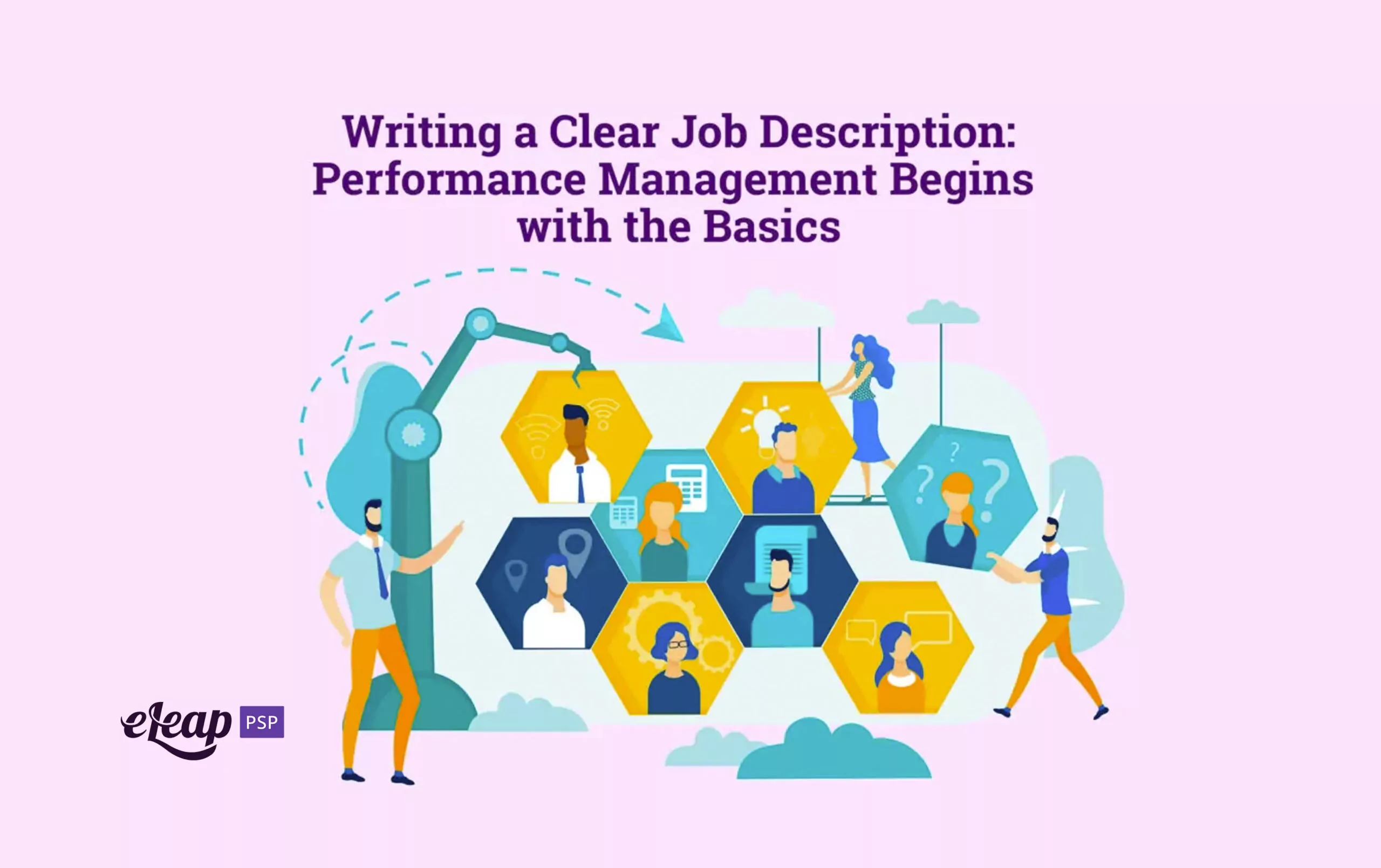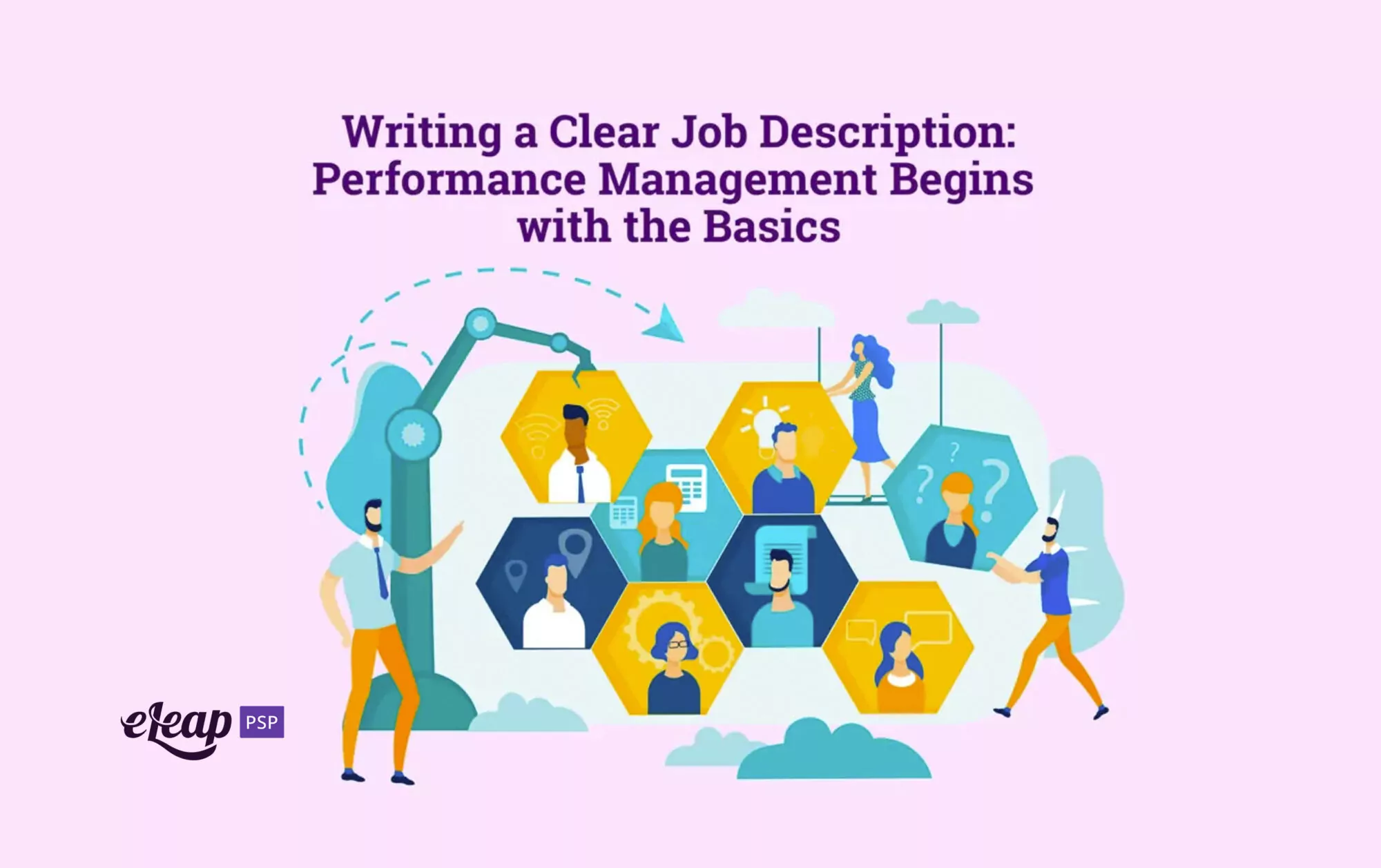Writing a Clear Job Description: Performance Management Begins with the Basics

When you think about employee performance management, chances are good some specific things come to mind. You probably picture conducting performance reviews, going through check-ins, or getting feedback about an employee from their peers. Those are certainly parts of the process, but the humble job description is perhaps one of the most crucial elements. Explore how eLeaP’s Performance Management Platform can simplify evaluations, boost productivity, and drive measurable results.
For too many people, a job description is something relegated to the recruiting process. However, the truth is that it is an invaluable aid for upping performance, and it also plays a critical role in HR, in managing employee expectations, and so much more. In fact, the job description is so important that you need to get it right the first time. In this guide, we’ll outline just how to create a clear job description, why it matters, and what else you should know.

Why Do Job Descriptions Matter?
First, let’s address the question of why job clear job descriptions matter in the first place. Simply put, they:
- Clearly communicate your expectations for the employee in terms of responsibilities and duties
- Spell out qualifications required to hold a specific position
- Detail the reporting relationship of the position within the team, department, and the wider organization
- Discuss the tools, equipment, skills, and other requirements to perform the job to existing standards
As you can see, a job description provides a great deal of critical information and lays the groundwork for a successful relationship with the employee. It also provides some pretty important benefits. However, there are drawbacks to job descriptions you should be aware of, as well.
Benefits of Job Descriptions
A clearly-written job description delivers critical benefits and opportunities to manage performance without even having to worry about a check-in or sit-down meeting. These include the following:
- Communicate Company Direction – A job description should ideally tell the employee what direction the company is going in, as well as how their efforts tie into that. It should explain the position’s responsibilities and duties, and those should be directly reflected in the company’s goals. If the description does not align your employees with the company’s goals and vision, it’s time to revisit it. Ideally, HR will create an accurate, evocative description with the help of the manager who will be responsible for monitoring the employee filling the position.
- Set Clear Expectations – Sometimes poor performance has nothing to do with an employee’s ability or lack thereof. In some cases, it’s all down to a lack of clear expectations being set. After all, how can an employee live up to your expectations if they don’t know that they exist? A clearly-written job description should accurately describe all the expectations for a particular position within the organization. This allows you to avoid misunderstandings and miscommunications while setting the employee up for success.
- Cover Your Legal Bases – A clearly-written job description does more than help employees succeed and live up to your expectations. It also covers you legally. For instance, if your job description does not cover the physical elements required to complete a job, you might fail to comply with the Americans with Disabilities Act (ADA). Many other rules and regulations also require compliance. Clearly describe all the duties and components of a position, but do so with an understanding of the regulations in force to cover your legal bases.
- Guide Other Employees – A job description acts as a guide for a specific employee (the one filling the role for which the description was written). However, it also works to guide other employees. Every position in your company affects others – they all share edges, so to speak. Other employees need to understand the limits of the responsibilities for a particular position so that they do not inadvertently expect too much from the employee or assume that they are somehow overstepping the bounds of their position by simply trying to do their job. It’s all about setting clear, defined boundaries and expectations for everyone.
Use these benefits to help guide you in crafting an accurate, clearly-written position for every position in the organization.
The Drawbacks of Job Descriptions
While job descriptions are crucial, they can also cause problems. Understanding these will help you craft clear, evocative descriptions that guide and support the employee (and thereby the organization as a whole).
- They Become Outdated – Businesses evolve faster than ever today, and that often means that an employee’s responsibilities and duties will change, too. In this fast-paced environment, job descriptions can quickly become outdated, so revisit them periodically to ensure that they are accurate and up to date.
- They Aren’t Granular – While job descriptions provide information about an employee’s responsibilities and duties, they may not provide a granular view of the day-to-day experience. For managers, it is important to go beyond the job description and dig into what an employee is actually expected to do daily, particularly when auditing performance, determining bonus eligibility, or increasing salary.
- They Are Sometimes Ignored – If a job description sits in a drawer (or digital file system) gathering dust, then it doesn’t matter how clearly-written it was. These tools must be central to your hiring, onboarding, and performance management processes. Otherwise, the time and effort that went into creating them were wasted. The employee will also lack critical guidance and information, leading to decreased performance and other problems.
Moving Your Organization Forward
Accurate performance management requires the right foundation. It begins during the recruiting process and is furthered during onboarding. A clearly-written job description can make a world of difference by helping employees understand your expectations, their role, how they support the organization in reaching its goals, and more. They are also critical for covering legal bases.
However, you cannot ‘set it and forget it’. Job descriptions should be dynamic documents that change as the organization evolves, so make sure you’re revisiting them periodically. Doing so will help ensure employee success, which supports outcomes for the team, department, and the entire organization.